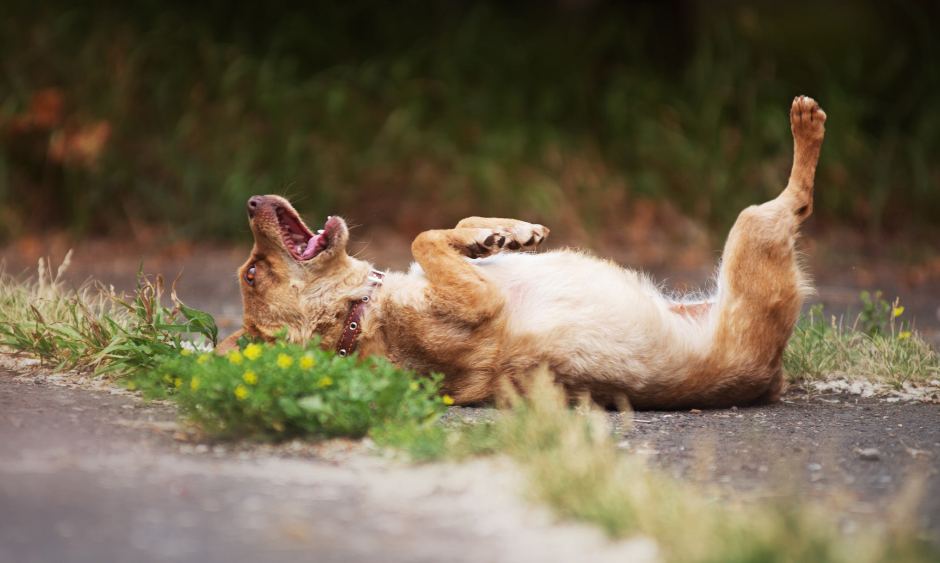Summertime is a lovely time to enjoy the outdoors with your lovely pets, but the summer also brings new dangers for our four-legged friends.
We’ve compiled a list of our top 7 potential dog hazzards to look out for so you can relax and enjoy the outdoors with your pet this summer.
1. Avoid sunburn
2. Protect your pet’s pads
3. Heat stroke
4. Bee-ware of bees
5. Check for grass seeds
6. Know your poisonous plants
7. Look out for external parasites
1. Avoid sunburn
Sunburn can be extremely sore and painful for your animals but be aware that like humans, excessive exposure over time can also cause cancer.
It’s possible to avoid sunburn by avoiding excessive time outdoors or long walks at the hottest time of the day.
Jennifer’s top tip:Avoid excessive time outdoors and apply sunscreen to avoid sunburn
2. Protect your pet’s pads
Pavements can get extremely hot during the summer months and your dog doesn’t wear shoes! Walking on extremely hot pavements can cause pads to blister and burn.
To avoid sore pads and overheating, try walking in shaded areas or opt for walking at cooler times of the day.
Jennifer’s top tip:
Test the road or pavement temperature by putting your hand on it, if warm to the touch, skip the walk.
3. Heat stroke
Heatstroke can be fatal to dogs!
During hotter temperatures, there are several things you can do to keep your dog safe:
Plan your walks for cooler times of the day or choose more shaded walks.
Keep a First Aid kit handy and carry water with you at all times.
Make sure your dog has plenty of shade and water when leaving them outdoors and if this isn’t possible, keep them inside during the hottest times of the day
Never leave your dog in a car unattended.
Keep an eye out for symptoms of heat stroke and dehydration:
- Dry pale gums
- Bright red tongue
- Excessive panting and dribbling
- Agitated and restless behaviour
- Increased heart rate
- Vomiting
Collapse
If you suspect your pet is suffering from heatstroke, move them to a cool place, preferably with a draught, wet their coat with cool – not freezing – water, and contact your vet immediately.
For other tips, check out our ‘how to keep your pooch cool in summer’ blog post.
Jennifer’s top tip:
Put some water in plastic container with some dry food or veg and freeze, when frozen and weather is hot turn out onto the grass. The dog will enjoy a lovely, iced treat, keeping cool and hydrated at the same time.
4. Bee-ware of bees!
Pets are often fascinated by bees and wasps and this curiosity can result in a sting.
It’s rare for animals to develop a severe allergic reaction but they may suffer from one of the following:
- Drooling
- Whining
- Swelling
- Pawing at the face, or mouth
- Biting at the site of the sting
- Holding up their stung paw
Jennifer’s top tip:
Bee stings don’t often affect an animal’s breathing but if you are concerned call your vet for advice.
5. Check for grass seeds
Grass seeds have the potential to cause significant pain to your dog if they get into their ears, eyes, paws and in extreme cases – under the skin where they can cause damage to vital structures and organs.
6. Know your poisonous flowers and plants
During the summer months, vegetation is in full bloom and whilst it’s lovely to see, it’s important to be aware that many plants can cause illness to dogs and some can be fatal, like these:
- Amaryllis bulbs (Winter and early Spring)
- Azalea (May – June)
- Daffodil bulbs (Spring)
- Jimson weed (July – October)
- Narcissus (November – April)
- Nightshades, including tomato plants (June – September)
- Ragwort – (July – October)
- Rhododendron (Spring to early Summer)
- Rhubarb (April-July)
For a comprehensive list, view the Dog’s Trust factsheet here.
Signs your dog has eaten something poisonous include:
- Vomiting
- Stomach upset
- Salvation
- Sleepiness or becoming wobbly
- In serious cases can cause heart rate, temperature, and blood pressure.
Jennifer’s top tip:
If your dog is showing any of the above signs, contact your vet immediately for advice – speedy medical attention will give your dog a better chance of recovery.
7. Check for external parasites
The warmer weather brings the outdoors life and makes external parasites livelier too!
Spring and summer mark the flea and tick season, and mosquitoes are also out and about and ready to pass on heartworm disease to dogs and cats.
Prepare to be more vigilant during the summer months and ensure your dog is up to date with any treatments.
Jennifer’s top tip:
Ensure your dog is up to date with flea and tick treatments
If you have any questions about keeping your pet safe in summer, please ask.




Comments are closed.